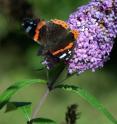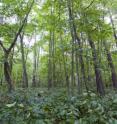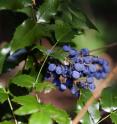When the butterfly bush blossoms
Related images
(click to enlarge)
Halle/Saale. Invasive plant species can flourish better in their new homes than in their place of origin. The reasons for this can be genetic changes or the lack of herbivores such as insects that first have to adapt to the newcomers. These are the conclusions of researchers from the Helmholtz Centre for Environmental Research (UFZ) from their research on Buddleia or the Butterfly bush (Buddleja davidii) and Oregon grape (Mahonia aquifolium). Due to this, invasive plant species would have an advantage over other native plant species and could therefore pose a threat to the ecological balance, as researchers have written in the scientific journal Diversity and Distributions. It blossoms in blue, white or lilac in many gardens. Buddleia was introduced to Europe about one hundred years ago from China and has been cultivated since then. The ornamental shrub soon became popular, but not only in gardens. In post-war Germany the shrub was also able to spread on the rubble of bombed inner cities and in the meantime Buddleia grows wild in large parts of West and South West Germany. Only in the continental East of the country, propagation is hindered by winter frosts. Although the blossoms of the Buddleia are aesthetically pleasing and provide a food source for butterflies, this beauty has a dark side to it however. This immigrant also known as the butterfly bush can easily go to seed and form dense populations. Thus it has the potential to displace native species and becomes a safety risk along railway embankments because it rampantly grows there. Switzerland, Spain and France are trying to combat Buddleia, while in the USA its propagation is being observed critically and in New Zealand Buddleia is causing economic problems because it suppresses native vegetation.
In order to improve knowledge about the mechanisms responsible for the spread of invasive species, UFZ researchers compared ten populations of Buddleia in Germany with ten populations in its original homeland, the south west Chinese province Yunnan. Although the climatic conditions are more favourable in China, the bushes were larger in Germany and produced more and heavier seeds. "From the plants in the Chinese homeland, 15 percent of the leaves had been eaten by insects. By comparison, in Germany only 0.5 percent", reports Susan Ebeling from the UFZ. "The intruder is not yet on the menu for our insects. Because there are no relatives of Buddleia in Central Europe, the insects need longer to adapt." The two Asian insect species that were used in an attempt to control the bushes in New Zealand, are not yet present in Europe.
The situation is different with another species that researchers investigated more closely. The Oregon grape (Mahonia aquifolium) originates from the West of the USA. In Oregon, the evergreen bush with its salient yellow blooms is even the official plant of the US Federal State and is therefore also known as "Oregon grape". In Europe the Oregon grape has a similar relative: the European Barberry (Berberis vulgaris). Native insects had millions of years time to adapt to the European Barberry and could now comparatively easily "switch" to the Oregon grape. The Oregon grape on the other hand could not develop any defence mechanisms against its herbivores.
Nevertheless, it prospers so well in Central Europe that the Swiss Commission for the preservation of wild plants requests owners of gardens to do without the cultivation of Oregon grape as a preventative measure: "Should one already have this species in one's garden, one must absolutely prevent any further propagation, on the one hand by removing the infructescence, and on the other hand by constantly removing any young shoots." In spite of herbivores, the Oregon grape is able to flourish, cover forest floors completely and consequently become a problem. "Its success obviously lies in cultivation. Through selection and hybridization it came to a genetic change, enabling the Oregon grape to grow larger in Europe than in its American homeland ", Dr. Harald Auge of the UFZ explains the research results. The biologist and his colleagues from Halle had collected seeds from Oregon grape plants in the USA, Canada, Germany and the Czech republic and had grown the plants under controlled conditions in a greenhouse.
Ornamental shrubs and cultivated plants constitute a majority of the alien plant species that have become a problem and are therefore referred to as biological invaders by specialists. Biological invasions caused by humans are one of the causes of the dramatic world-wide decrease in animal and plant species. According to a study conducted by the Federal Environment Agency, the economic costs of 20 alien species investigated, amounted to approximately 167 million Euros in the year 2002 in Germany. More recent figures are not yet available. In the near future, health care costs caused by the highly allergenic Ragweed are to be investigated by the UFZ and financed by the Federal Ministry of Research.


